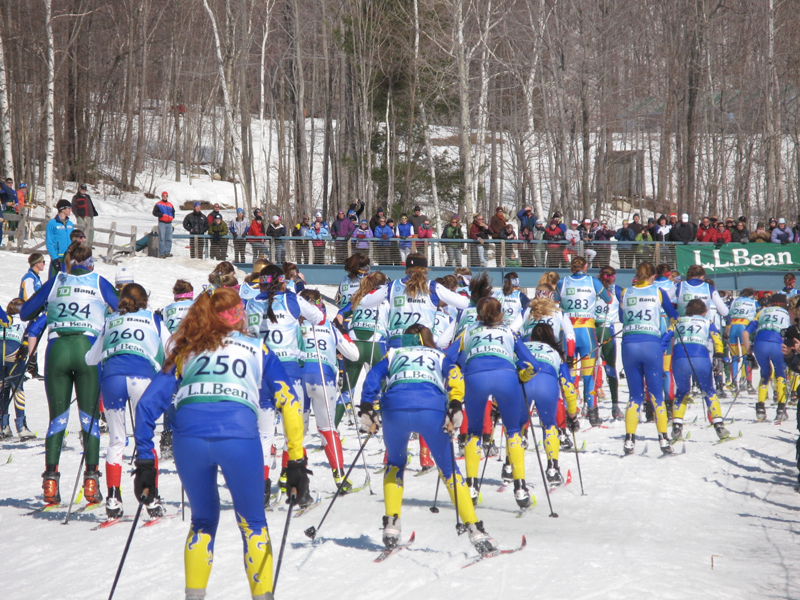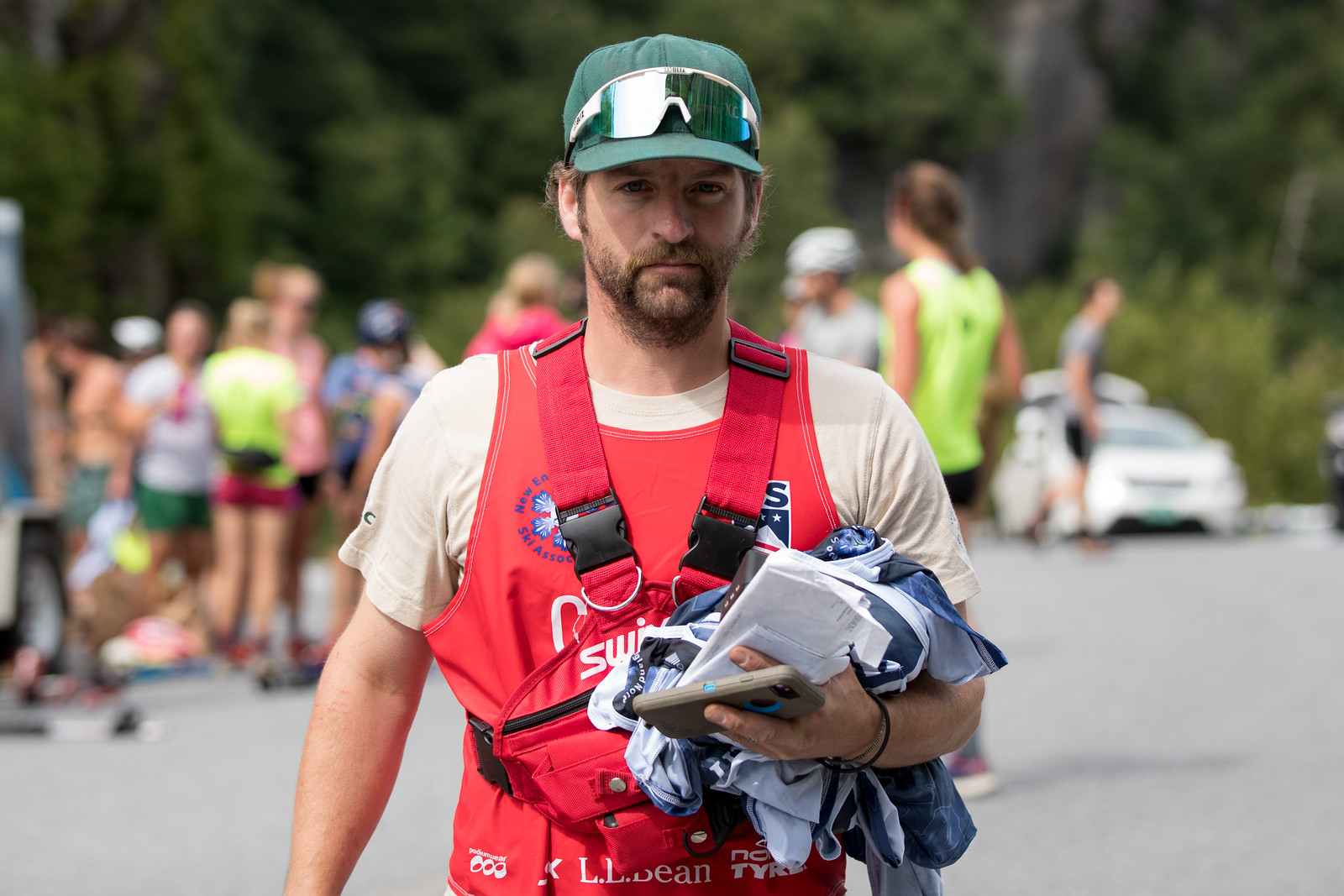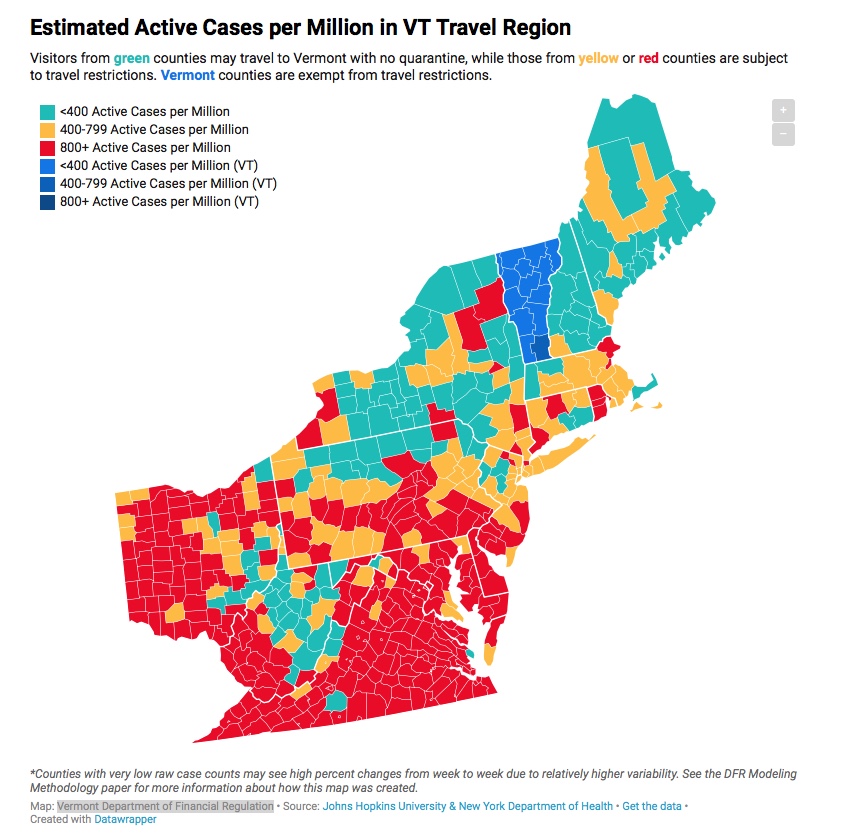For skiers and race organizers, remaining nimble and realistic are keystone 2020 attributes as the global pandemic commands our attention. Amidst the disruption, the New England Nordic Ski Association (NENSA) remains committed to organizing races for the 2020-2021 season. Justin Beckwith, Competitive Program Director at NENSA, said the aim is clear during uncertain times: under-promise and over-deliver.

As a case study, New England poses several challenges. Geographically several states with differing Covid-19 mandates share borders or are within relatively close proximity to one another. In this piece, we’ll use Vermont as our Covid-19 focal point. Vermont’s Agency for Commerce and Community Development has posted criteria for those traveling from out of state along with a map to make travel decisions easier.
On the color-coded map depicting both state and county borders, it’s easy to determine who can travel to Vermont seamlessly with zero quarantine requirements. (There are no travel restrictions within Vermont.)
Hypothetically, using the current data, if you are a ski racer from a New England county and your county has between 400-799 active cases per million or greater, you are likely looking at a 14-day quarantine when entering Vermont, “or a 7-day quarantine followed by a negative test in [your] home state and enter Vermont without further quarantine restrictions.”
Currently, much of Massachusetts falls in the 400-799 active caseload category, as do several counties in Maine and a single New Hampshire county.
This all gets tricky for those crossing state borders to race.
Compounding the complexity, each state has unique caps on maximum group sizes for outdoor events. In Vermont, a state with favorable Covid-19 metrics relative to the nation as a whole, “outdoor organized events” are limited to 150 people. Skiers, coaches, spectators, volunteers, and officials — they add up quickly. The aim is to minimize the total number of individuals on-site for a race. That, said Beckwith, requires rolling race start times and the ability for racers to arrive promptly and leave the venue quickly post-race.

“We are trying to really promote the local races, so we are saying stay home, try a popular race so to speak, that is a good step for a high school kid versus going to an Eastern Cup during a year where we would rather have slightly reduced field sizes to make it easier to pull events off,” said Beckwith. “Once you get to 100 competitors, that is pretty close with volunteers and coaches, if not over, to the cap here in Vermont.”.
Here’s our closer look at NENSA’s plan and how it may over-deliver. Regional will be the operative word as NENSA is encouraging skiers to minimize out-of-state travel.
“We are starting with the language of advising people to race within their region. Vermonters could go to the two Eastern Cups in Vermont, maybe they slide over to the one in Dublin, New Hampshire because it is not that far away,” Beckwith said. “Kids from Maine would do the Eastern Cup in Maine, they could slide over to New Hampshire and do those.”
On NENSA’s website, they have a dedicated page for COVID-19 considerations. There, interested racers can find specific contingencies for Eastern Cups, Eastern High School and U16 Championships, Women’s Day, the BKL Festival, and popular racing. Across the board, all NENSA races will be individual start (no mass start or sprint heats for the 2020-2021 season).
With the Eastern Cups arguably the most complex, we’ll focus on those contingencies. The streamlining and social distancing begins on October 1, when NENSA will open their portal for purchasing a bib and timing chip. The bib and timing chip remains with the skier for the season. Beckwith said NENSA plans for “touchless registration and timing” and no day of race registration.
Plan 1:
- All races will be individual start with start times organized by age group.
- On the Wednesday before the race, all athletes, coaches, athlete relatives attending the race, volunteers, timers, and staff must complete an on-line NENSA Event Health Screening Tool. This includes a temperature check.
- Limited spectators will be allowed at the venue with the possibility of no movement beyond their personal vehicles.
- No on-site indoor waxing will be available.
- Likely limited coach access to the course.
- Bathrooms will be assigned by state.
- All present at the race site must wear a “face covering and cover their mouth and nose at all times. Athletes/coaches must cover their nose and mouth in the start and finish area and if they are within 6 ft of another individual on course.”
Plan 2:
- Essentially, Plan 2 calls for eastern Cups to be moved to February or early March.
Plan3:
- “Regional races within states in New England – states determine “Championship” Teams.
Plan 4:
This plan, the last on the list, appears to be a fall back in which even a semi-large gathering of people is untenable.
- Races will be run over the course of nine days. Racers sign up for a start time and complete their race. NENSA makes clear in Plan 4 that during hours when racers will be present, NENSA timers and race marshals will officiate.
Beckwith added that no Eastern Cup races have been calendared with U.S. Ski & Snowboard, however, a schedule of events can be found on the NENSA site.
The most critical piece, reiterated numerous times by Beckwith, was safety. That tenant is front and center on the NENSA website: “Our first objective is to ensure the health of our community in New England,” reads the language.
“You have to think about this in the context of staying healthy and allowing everybody to participate,” Beckwith said. “Trying to deliver a little lower level event and do a really good job versus ‘oh yeah this is business as usual.’ We are probably going to have people go to all the races. I do not think we are going to prohibit that. But we might, for instance, format the Junior National criteria in a way so people feel like they don’t have to go to every race. It is again going to come down to education and messaging.”
Jason Albert
Jason lives in Bend, Ore., and can often be seen chasing his two boys around town. He’s a self-proclaimed audio geek. That all started back in the early 1990s when he convinced a naive public radio editor he should report a story from Alaska’s, Ruth Gorge. Now, Jason’s common companion is his field-recording gear.




